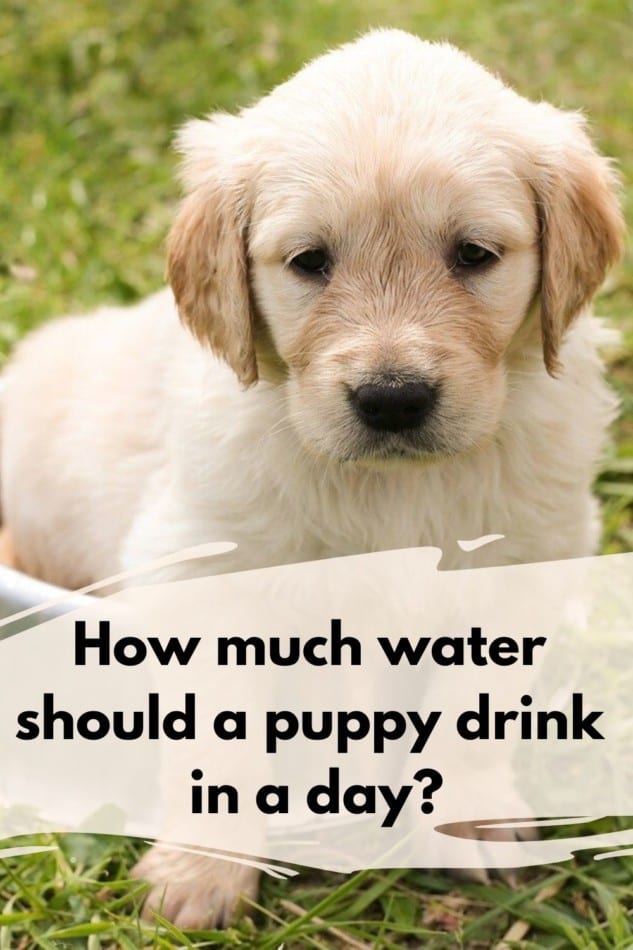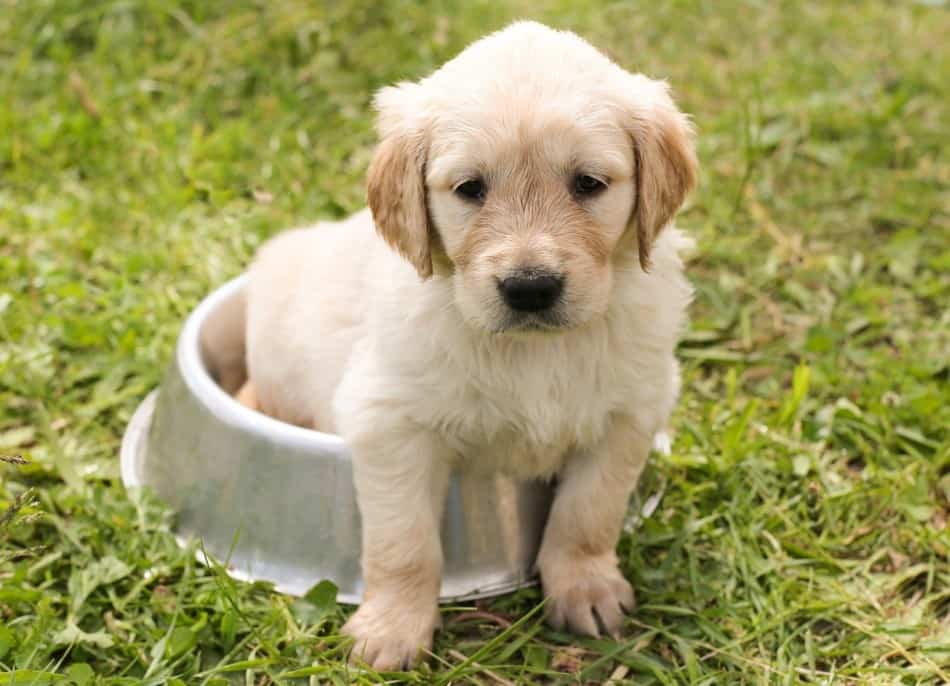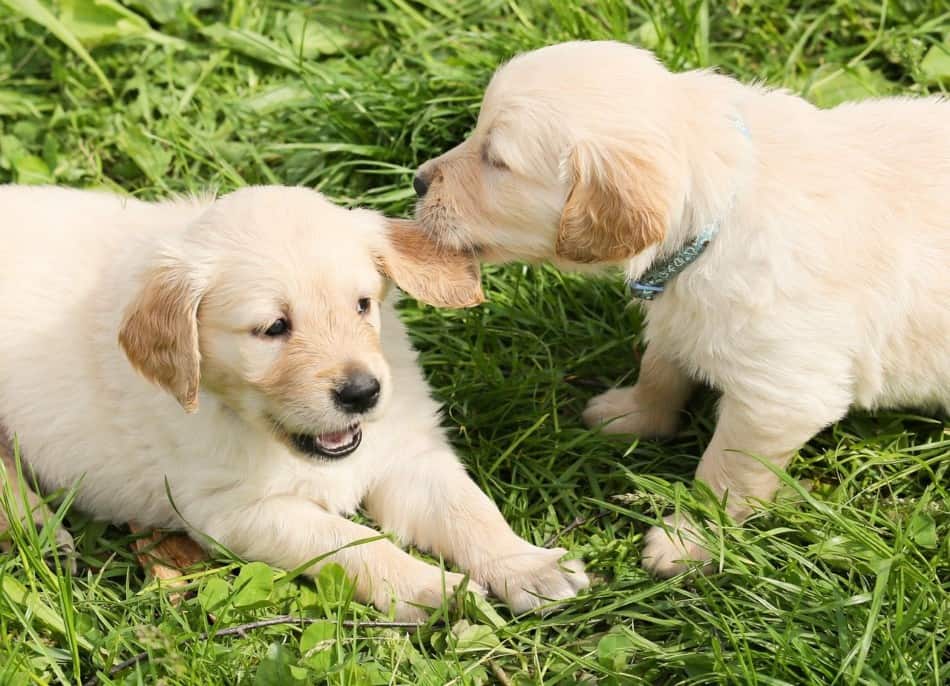If you have just adopted your first puppy, you’re probably trying to speed-learn about its water intake. Puppies are always on the move, so they need a lot of water to stay healthy. You should watch their water intake carefully. Too little can lead to organ failure, kidney stones, or even death.
Similarly, drinking too much water can result in electrolyte imbalances or bloat. This brings us to the question, how much water should a puppy drink in a day? It depends on age, diet, metabolism, activity level, and weather conditions.
How much water should a puppy drink in a day? The short answer is as much as he needs. As long as your puppy has access to fresh water all day, it will drink as much as it needs. One trick for making sure that your pup has enough water, without spilling it everywhere, is to three-quarter fill its water containers, then freeze them. During the day, the ice will thaw, and your bundle of fur will have a continuous supply of fresh water. Make sure there is a small bowl of ordinary water available first thing in the morning, so that your pup has a supply before the ice melts.

A general rule of thumb is to give your puppy one ounce of water per pound of body weight. For example, if your puppy weighs 40 pounds, you should be giving it about 30 ounces of water every day.
This is equivalent to 60-90 millilitres per kilogram per day. A small puppy that weighs 10 pounds should be drinking 1 cup (240 millilitres) of water per day. On active days, a puppy should drink 8 ounces of water every day. This amount can go up if you walk it around the neighbourhood.
Table of Contents
Why Water is Important for Your Puppy
About 80% of a puppy’s body weight is made of water. Water stimulates the metabolic processes – everything from breathing, learning progress, brain development and digestion to blood circulation.
From a scientific and biological standpoint, blood is composed mostly of water, and carries oxygen around your puppy’s body. Secondly, it eliminates harmful toxins, which can harm the vital organs.

During the summer months, water helps to regulate the internal temperature of puppies. You may see your puppy panting in hot weather. Panting is a way of your puppy cooling down as it releases water through respiration; however, this loss of water from the tongue means that your pup will need to drink more water than usual.
If your puppy is on medication, discuss with your vet whether you should reduce or increase the water intake.
Is My Puppy Drinking Enough Water?
The amount of physical activity your puppy engages in plays a role in how much water it needs. If your puppy is not very active, it will need less water. An active pup, on the other hand, will need to have access to water throughout the day to avoid dehydration.
Water Requirements of Puppies
Your 10-pound pup, if not highly active, should drink 8.5 ounces of water a day. A moderately active 10-pound puppy should be drinking 12.5 ounces of water daily. Active 10-pound puppies will need to drink up to 17 ounces of water each day.
Most 20-pound puppies will need at least 17 ounces of water each day if they are not highly active. If your 20-pound pup engages in mild activity they will need 25 ounces of water per day. If your 20-pound puppy is highly active, then they will need up to 34 ounces of water per day to stay properly hydrated.
Puppy Dehydration
Most puppies self-regulate naturally when it comes to the amount of water they drink. However, there are times when your puppy may not drink enough water and therefore risks dehydration. Several things can cause dehydration, including excessive urinating, vomiting, diarrhoea or fever.
A puppy that eats mostly dry food, may not be getting enough water. Some pups just don’t seem very tempted by their bowl of fresh water. Apart from noticing any of the causes, you will be able to tell if your puppy is drinking enough, by monitoring its water intake, using the ratio of water to body weight – 8.5 ounces of water per 10 pounds of weight for an inactive puppy.

How Can I tell if My Puppy is Dehydrated?
If a puppy doesn’t drink enough water, it will become dehydrated. One test is to grab the scruff of its neck, stretch it and let go. If the skin doesn’t return right back, then your pup may well be dehydrated. When the skin is slow at snapping back, the dehydration level could be 7-10%.
Another test is to press a finger against its gums. Generally, the area should turn white and return to the usual pink colour within two seconds. If it takes longer than this, your puppy could be dehydrated.
By checking the puppy’s capillary line, you block the blood flow. If the pink color doesn’t return at all, your puppy could be dehydrating to dangerous levels.
Dehydrated pets may also have dry, sunken eye balls and a dry nose and mouth.
Dehydration can lead to some very serious health concerns. Providing your puppy with a supply of fresh water is particularly important for good health of the puppy.
Other signs of a dehydrated puppy include:
- lethargy
- sunken eyes
- lack of appetite
- depression
Many things can cause dehydration. Apart from overheating, a puppy might urinate excessively, suffer with diarrhoea, or vomit. If you are at all unsure of what might by causing the dehydration and are at a loss as to what to do, take your puppy to the vet for an immediate evaluation.
What to Do When You Notice Your Puppy is Dehydrated
When your puppy is panting, it means it’s thirsty, so drinking water will help it recover fast. However, if you spot signs of severe dehydration you should call the vet immediately. Never ignore the red flags as that could be a sign of an underlying problem.
During the sweltering summer months, the puppy will naturally drink more water. To ensure it doesn’t drink too much too quickly, you should add ice cubes in the drinking water. When the puppy licks the cubes, it will cool down.
Another way of managing dehydration is to place your puppy’s water bowl in a strategic place. This could be near its food, its bed, or wherever it normally likes to relax, etc.
For an under-drinking pup, offer it some chicken or beef broth. Be sure to add fresh water gradually as they sip the broth. You can also up the flavour by adding a sprinkle of food topper such as Barker & Barker‘s liver or chicken flavour to your pup’s water. Pets Purest Scottish Salmon Oils, may also tempt your puppy to drink, these oils are packed with Omega-3 and Omega-6 fatty acids which your fur baby could be enticed to taste from its water bowl.
Overhydration in Puppies
A puppy can easily overhydrate, this condition is known as water intoxication. For instance, it can drink too much water while playing in water or swimming. Some of the symptoms of water intoxication include loss of coordination, staggering, pale gums, bloating, dilated pupils, etc. Keep in mind that your puppy could be drinking too much water because of diabetes, infection of the uterus, or a kidney issue.
If you suspect that your dog is overhydrated or exhibiting any of these symptoms, contact your veterinarian as soon as possible:
- Lethargy
- Nausea
- Loss of coordination
- Staggering
- Bloating
- Dilated pupils
- Excessive salivation
- Vomiting
- Pale gums
For over-drinkers, you should monitor the amount of water your puppy drinks. While you can leave a whole bowl of water for your pup, you should ration it. It is recommended to limit water for puppies to every two hours or so.
For night-time control, you can place a water feeder in the puppy’s crate, this gives access to water but limits it to sips, rather than gulps. Your veterinarian may also recommend that you allow the puppy to lick cold bottles to limit the water intake.

Water for Growing Puppies
While a puppy can depend on its mother’s milk when still very young, it will need fresh water when it starts eating canned/wet food; the weaning process.
Experts recommend that you give a puppy a half-cup of water every two hours. Also, you should keep a bowl of fresh water available, so that it can drink whenever it feels like. Be sure to monitor how much it drinks as too much can be detrimental to its health.
How to Monitor Your Puppy’s Water Intake
The easiest way to monitor the water intake of your puppy is to mark a gallon jug. Every time the water bowl is empty, you should use the pre-allotted amount.
Another approach is to record how much water the puppy is drinking every day. Don’t forget to include how often you let it out for bathroom breaks. If you find out the puppy is begging you to be out in the middle of the night, you may want to limit the water intake. At around 12 weeks of age, a puppy should be able to hold for a couple of hours.
If you’re concerned that your puppy isn’t drinking enough, you should use the same monitoring rules. Be on the lookout for signs of dehydration but if there are none, there’s no reason to be overly concerned.
Keep the Water Clean and Fresh
Puppies tend to ignore stale water. To ensure your pup remains healthy, you should change the water daily. What’s more, you should clean the bowl regularly to discourage the growth of bacteria and viruses from the puppy’s saliva. If you use a water fountain to hydrate your pet, make sure you clean it least once a week.
Frequently Asked Questions
Q. How can I encourage my puppy to drink more water?
A. Replace the water in its bowl frequently throughout the day. Water can become contaminated with dust, hair and other unwanted particles, making it unappealing to your pup. Verbal praising or giving a treat when your puppy drinks as a ‘reward’ gives positive reinforcement. Make sure your puppy’s water bowl is not in a ‘high traffic’ area, it may be intimidated or overwhelmed with bustle and noise going on around.
Q. Why is My Puppy Drinking a Lot of Water?
A. Your puppy may simply be thirsty, happily gulping down every drop of water from their bowl as soon as you fill it. If your pup has been active all day, or has become overheated, it may well need to drink a lot of water. If that is the case, the amount of water they are drinking is really not a cause for worry.
Q. Should I Leave Water Out for My Puppy at Night?
A. Leaving water out overnight for you puppy won’t do any harm; it probably won’t need it. However, after a particularly active day, your furry babe may need to drink water at night. Just remember though, if your puppy has been drinking water all night, it’s likely to wake you up to let you know that it needs to go outside.
Conclusion: How Much Water Should a Puppy Drink in a Day?
Just like humans, water is essential in a dog’s life. Yet, some don’t drink enough while others drink too little. While a puppy should take one ounce of water per pound of body weight, other factors contribute to the amount of water it takes.
The basic rule is that it should drink 1 ounce of water per pound of body weight. However, the actual amount can depend on other factors like the food your pup eats, the amount of exercise, weather, etc. If you suspect the water intake for your puppy has gone down, you should call a vet to establish the exact reason.
Of course, the answer to the question of how much water should a puppy drink in a day is dependent on a number of factors. If your pup spends most of its time in a climate-controlled house, it will need less water. However, a puppy which spends most of its time outside all day in hot dry conditions, will need to drink more water in order to stay adequately hydrated.
Whilst you’re researching topics like ‘how much water should a puppy drink?’ you may like to read our article on the Top 10 Puppy Dog Beds.
All products in this article can be found on amazon, any links which are clicked and subsequently purchased may provide us (bowwowtech.co.uk) with a small commission. Any commissions earned are reinvested to enable us to produce more articles and provide educational material to visitors to our site.
Bowwowtech.co.uk does not provide veterinary advice. Our aim is to provide the reader with information to enable them to make a good decision when making a purchase. All content is therefore for informational purposes only.

